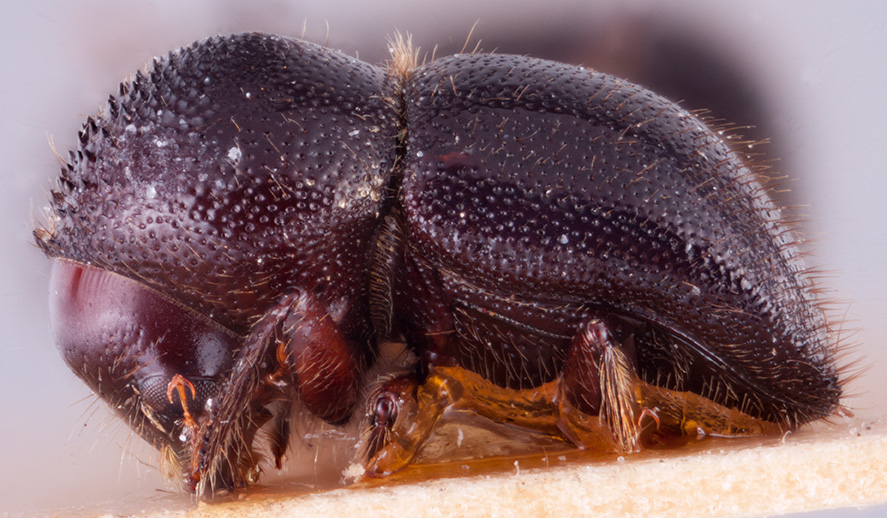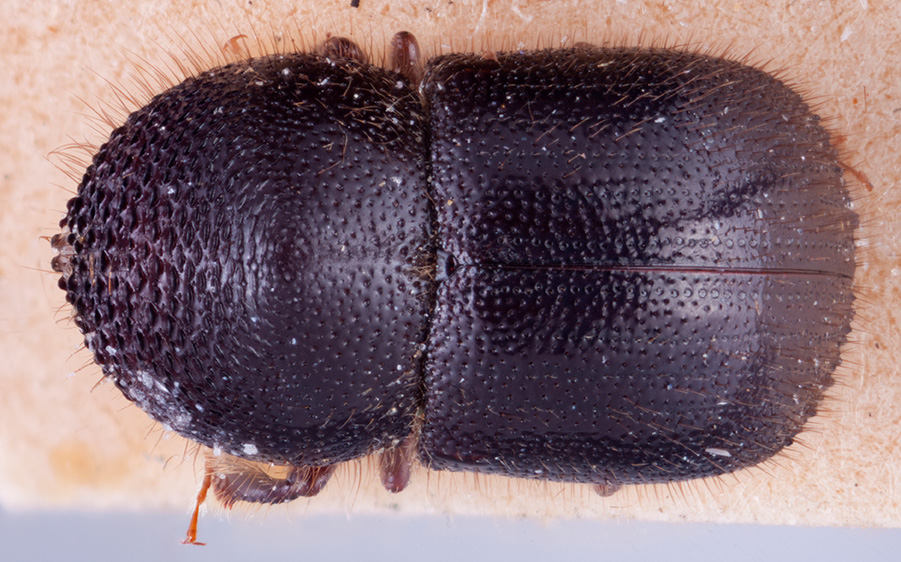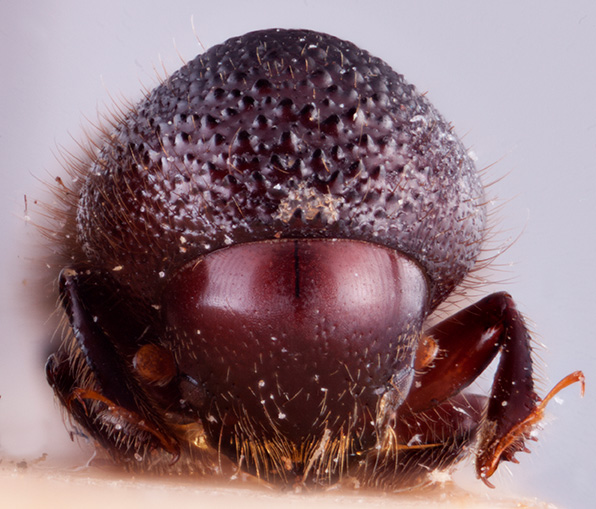Anisandrus ursulus
|
Anisandrus ursulus lateral; R.K. Osborn |
|
Anisandrus ursulus dorsal; R.K. Osborn |
|
Anisandrus ursulus declivity; R.K. Osborn |
|
Anisandrus ursulus frontal; R.K. Osborn |
Taxonomic history
Xyleborus ursulus Eggers, 1923: 173.
Xylosandrus ursulus (Eggers): Wood and Bright, 1992: 801.
Anisandrus ursulus (Eggers): Dole and Cognato, 2010: 527.
Diagnosis
4.3−4.9 mm long (mean = 4.5 mm; n = 5); 1.88−1.96 times as long as wide. This species can be distinguished by the mesonotal mycangial tuftmycangial tuft:
tuft of setae that denotes the mycangia exterior opening
 the length of the scutellumscutellum:
the length of the scutellumscutellum:
a shield-like sclerotized plate located at the midpoint of the elytral base
; elytralelytral:
pertaining to the elytra
discdisc:
the flat central upper surface of any body part (e.g. pronotum and elytra) convexconvex:
convexconvex:
appearing rounded ; declivitydeclivity:
; declivitydeclivity:
downward slope of either the pronotum or elytra
 obliquely truncatetruncate:
obliquely truncatetruncate:
appearing cut off or suddenly shortened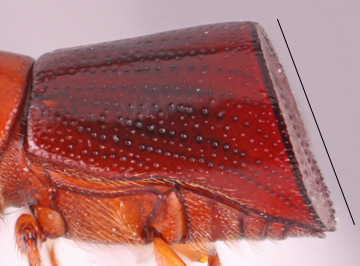 with laterallateral:
with laterallateral:
pertaining to the side
 margins obliquely costate; declivitydeclivity:
margins obliquely costate; declivitydeclivity:
downward slope of either the pronotum or elytra
 opalescent and unarmed; declivitaldeclivital:
opalescent and unarmed; declivitaldeclivital:
pertaining to the elytral declivity
striae not impressedimpressed:
a depression in a surface
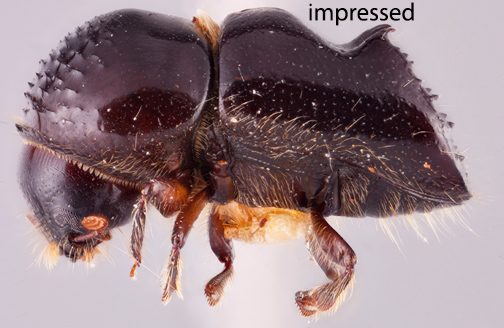 ; body stout and densely covered by erecterect:
; body stout and densely covered by erecterect:
pertaining to setae that have their apices directed away from the body and appear straight
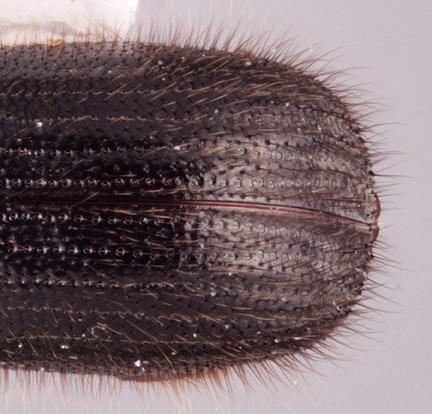 dark brown pubescencepubescence:
dark brown pubescencepubescence:
fine short setae
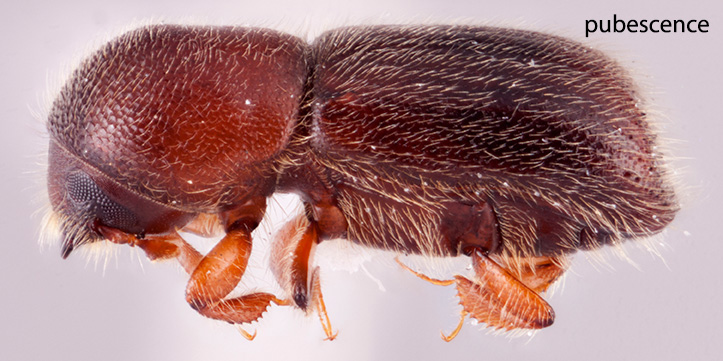 .
.
Similar to Cnestus mutilatus and Hadrodemius species but scutellumscutellum:
a shield-like sclerotized plate located at the midpoint of the elytral base
visible, declivitydeclivity:
downward slope of either the pronotum or elytra
 less steeply truncatetruncate:
less steeply truncatetruncate:
appearing cut off or suddenly shortened , posterolateralposterolateral:
, posterolateralposterolateral:
relating to end of the side part/portion
 carinaecarina:
carinaecarina:
an elevated ridge or keel, not necessarily high or acute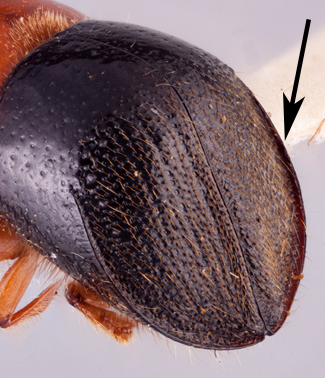 absent, procoxae contiguous, and the mesonotal mycangial tuftmycangial tuft:
absent, procoxae contiguous, and the mesonotal mycangial tuftmycangial tuft:
tuft of setae that denotes the mycangia exterior opening
 the length of the scutellumscutellum:
the length of the scutellumscutellum:
a shield-like sclerotized plate located at the midpoint of the elytral base
.
May be confused with
Anisandrus hirtus, Cnestus ater, C. mutilatus, and Hadrodemius spp.
Distribution
China (Fujian, Guangdong, Guangxi, Jiangxi, Yunnan), India (Nicobar Is., West Bengal), Indonesia (Bali, Batoe Is., Java, Maluku, Sulawesi, Sumatra), Laos, East & West Malaysia, New Guinea, Philippines, Solomon Islands, Taiwan, Thailand, Vietnam
Host plants
polyphagous (Browne 1961bBrowne 1961b:
Browne FG. 1961b. The biology of Malayan Scolytidae and Platypodidae. Malayan Forest Records 22: 1-255.)
DNA data
Sequences available for COI and CAD.
COI: GU808723.1; MN619853
CAD: GU808645.1; MN620146

